Key takeaways
- Cooking challenges inspire creativity and encourage experimentation with new flavors and techniques.
- Zesting enhances the flavor profile of dishes by capturing essential oils, making meals feel fresh and exciting.
- Using the right tools, like a Microplane, can improve the efficiency and enjoyment of the zesting process.
- Proper zesting technique includes avoiding the bitter white pith, using fresh lemons, and cleaning tools immediately after use.
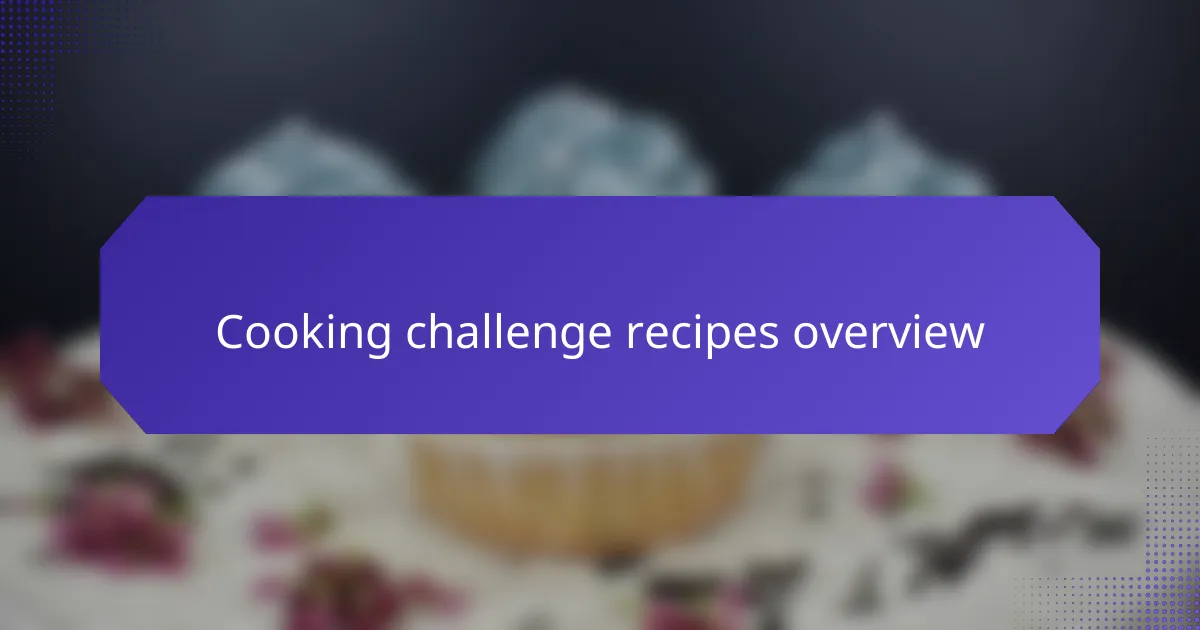
Cooking challenge recipes overview
Cooking challenges can be a thrilling way to explore new flavors and techniques in the kitchen. I remember the first time I participated in a cooking challenge; it sparked my creativity and pushed my culinary boundaries. Have you ever felt that rush of excitement when trying to create something unique under a time constraint?
Each recipe we tackle in a cooking challenge not only asks for skill but also encourages us to think outside the box. I’ve found that these challenges often lead to kitchen experiments that might not happen in my everyday cooking routine. It’s where the magic happens—discovering new methods and flavor pairings that surprise you.
As we dive into specific recipes, I challenge you to embrace the unexpected. What if you’ve never zested a lemon before? That small action can elevate your dish beyond what you thought possible. Cooking challenges are all about growth, learning, and, most importantly, having fun while we experiment!
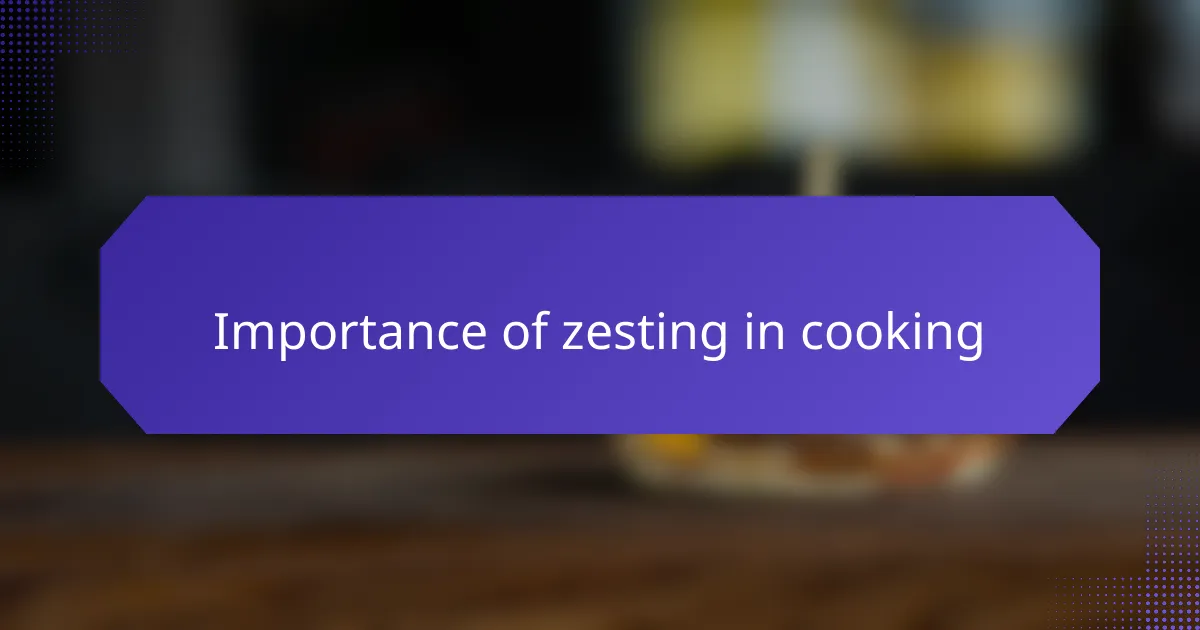
Importance of zesting in cooking
Zesting is often an overlooked step in cooking, but it can dramatically enhance the flavor profile of any dish. I remember the first time I zested a lemon for a simple pasta sauce; the burst of citrus aroma transformed my cooking experience entirely. Have you ever noticed how a little zest can brighten up a recipe and make it feel fresh and exciting?
When you zest a fruit, you’re tapping into essential oils that contribute vibrant flavors. In my cooking adventures, I’ve discovered that just a teaspoon of lemon zest can elevate everything from baked goods to salads. It’s amazing how something so small can pack a punch that lingers on your palate. Have you tried it yet? I promise it’s worth the effort!
Zesting doesn’t just add flavor; it also brings a visual appeal to your dishes. A sprinkle of colorful zest can bring a dish to life, making it more inviting. It’s these little details that can make your meal feel special and well thought out. As you embark on your own cooking challenges, remember that zesting can be your secret weapon for making a dish truly memorable.

Tools for zesting lemons
When zesting lemons, having the right tools can make all the difference. I remember the first time I attempted this technique; I struggled with a box grater and ended up with more juice than zest. That experience taught me the value of using specialized tools designed for this task, and I quickly found that the Microplane was a game changer in my kitchen.
Here’s a quick list of essential tools for zesting lemons that can enhance your culinary journey:
- Microplane Zester: Perfect for fine zesting; it creates fluffy piles that mix beautifully into dishes.
- Box Grater: While not my favorite, it can work in a pinch, but be cautious of the juice!
- Zesting Tool: A handheld option with small holes that can give you great control.
- Chef’s Knife: For those who prefer to zest by cutting thin strips, it requires a steady hand.
- Cutting Board: A sturdy board is essential to keep your workspace organized and safe.
These tools not only improve comfort and efficiency but also elevate the final flavor of your dishes. With practice and the right equipment, zesting lemons can quickly become a delightful part of your cooking routine.
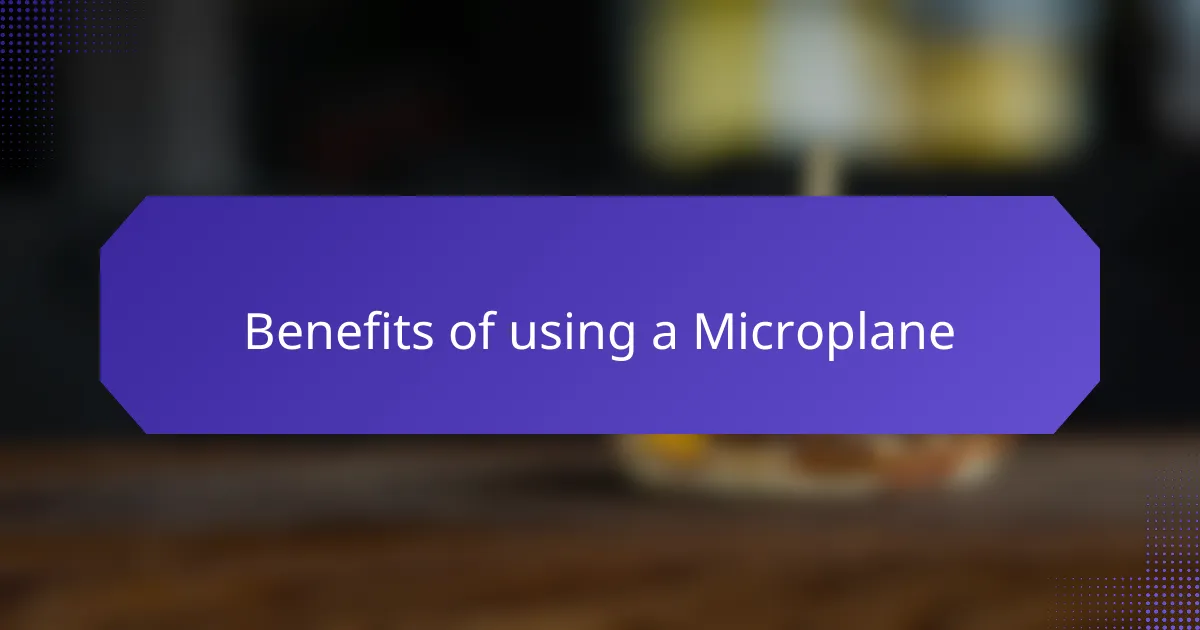
Benefits of using a Microplane
Using a Microplane to zest lemons is a game changer in the kitchen. I still remember the first time I used one; the aroma of freshly zested citrus filled the air, and it reminded me of sunny summer days. The fine grating allows you to capture the essential oils from the lemon peel, amplifying the flavor in your dishes without the bitterness you can get from the white pith underneath.
One of the best aspects of a Microplane is how effortless it makes zesting. Unlike traditional zesters, it’s incredibly efficient and requires minimal effort, which is a blessing when you’re trying to whip up a recipe quickly. Plus, cleanup is a breeze since most Microplanes are dishwasher safe, making it even easier to incorporate this tool into my cooking routine.
Benefits of Using a Microplane:
- Creates fine, even zest for a burst of flavor without bitterness.
- Saves time and effort compared to traditional zesting methods.
- Versatile for grating hard cheeses, spices, and even garlic.
- Easy to clean and store, fitting into small kitchen spaces.
- Enhances aromas in a dish, elevating the overall culinary experience.
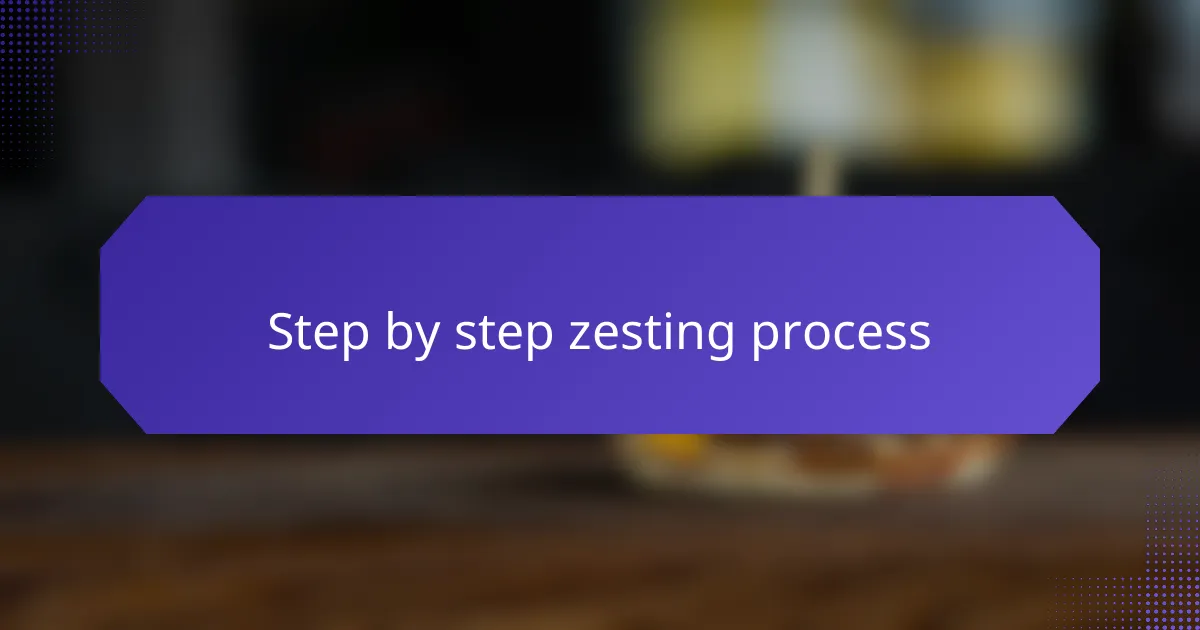
Step by step zesting process
Zesting lemons with a Microplane is a simple yet rewarding process that can elevate your dishes with fresh, vibrant flavor. I remember the first time I used a Microplane; I was amazed at how effortlessly it transformed the lemon’s bright skin into fragrant shavings. As I zest, I keep the lemon steady on the counter, gliding the Microplane back and forth to ensure I only get the yellow part and leave behind the bitter white pith.
Here’s the step-by-step zesting process I follow:
- Start with a clean lemon; wash it under water to remove any waxy residue.
- Place the Microplane over a plate or a clean cutting board to catch the zest.
- Hold the lemon firmly in one hand and the Microplane in the other, angling it slightly.
- Lightly press the lemon against the Microplane and move it in a downward motion, zesting off the yellow outer layer.
- Rotate the lemon as you zest, ensuring even coverage, until you have enough zest for your recipe.
This method is not only efficient but also enhances the cooking experience by filling the kitchen with that unmistakable citrus aroma.
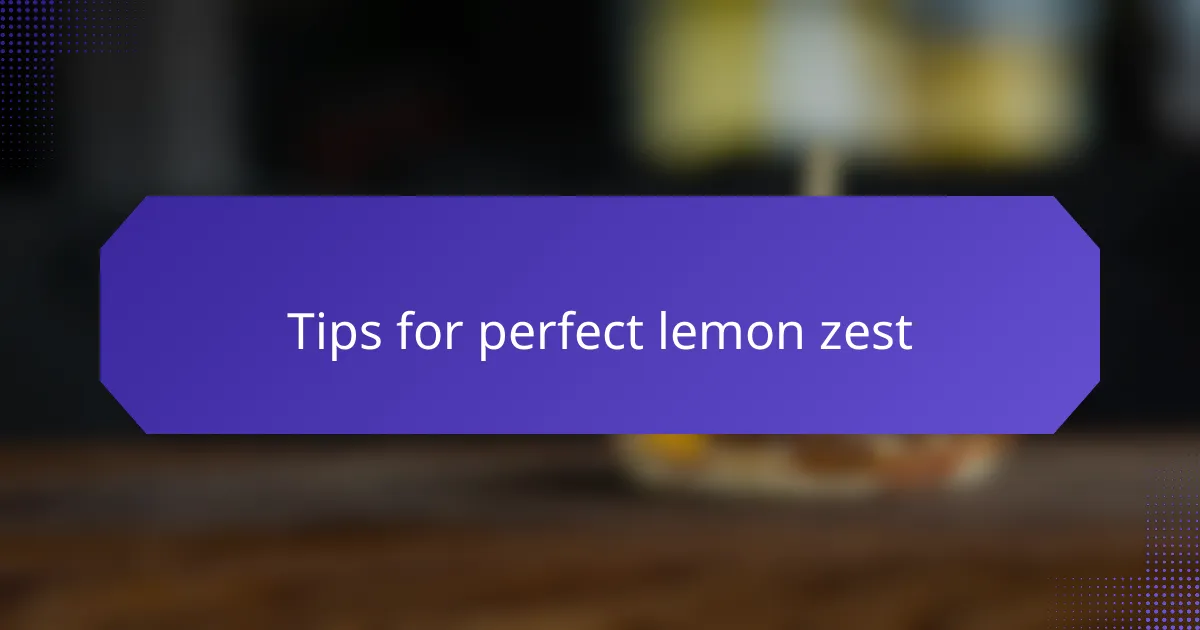
Tips for perfect lemon zest
When it comes to zesting lemons, experience has taught me that using the right technique can make a world of difference. I find that the zest of the lemon adds a brightness and depth to dishes that are hard to replicate with juices alone. Always opt for fresh, firm lemons, as they provide the best zest.
One key tip is to zest only the yellow part of the lemon peel; the white pith underneath is bitter and can ruin the flavor. I like to gently roll the lemon on the countertop beforehand. This helps release the oils and makes zesting much easier.
Another personal trick I’ve learned is to keep the Microplane at an angle while zesting. This gives me better control and prevents the blade from getting clogged. Plus, don’t forget to wash your Microplane immediately after use; the oils can stick, making it harder to clean later.
| Tip | Description |
|---|---|
| Use fresh lemons | Firm, bright lemons yield the best zest. |
| Only zest the yellow | Avoid the bitter white pith to ensure a pleasant flavor. |
| Angle the Microplane | Better control and prevents clogging while zesting. |
| Clean immediately | Washing your Microplane right away prevents oil buildup. |

Personal experiences with zesting lemons
Zesting lemons has become one of my favorite moments in the kitchen. I still vividly recall the day I first experienced that bright, citrusy aroma wafting through the air as the Microplane touched the peel. The simple act of zesting seemed almost magical, transforming my dish into something vibrant and fresh. Have you ever had that feeling, as if a single ingredient could breathe life into your cooking?
On another occasion, I found myself zesting lemons for a dessert recipe that felt mundane at first. As I carefully glided the lemon against the Microplane, I was surprised by how much zest I gathered—much more than I anticipated. My initial uncertainty faded, replaced by excitement. It was a small victory that made me appreciate how a little effort can yield extraordinary flavors.
Sometimes, I feel like zesting lemons mirrors my own cooking journey. It taught me to embrace experimentation, reminding me of the joy that can come from small details. Have you thought about how something as simple as zest can elevate a dish? I can assure you, once you incorporate zest into your cooking, you’ll find it hard to go back!


